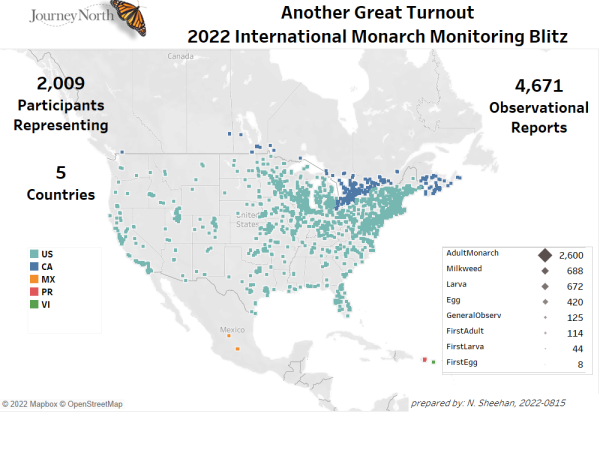Thank You for a Summer of Monarch Monitoring
What a great way to end a summer of monitoring monarchs. The Monarch Blitz was a success. Thank you for contributing to this international effort.
Monarch Blitz a Huge Success — Thanks to You!
Thank you for participating in the 2022 International Monarch Monitoring Blitz! From July 29 to August 7, Journey North volunteers across North America reported over 4,600 monarch and milkweed observations. This far exceeded last year's total of 2,900 observations.
Journey North and other participating organizations will share data gathered during the Blitz with the Trinational Monarch Knowledge Network, a central hub for monarch data.
The Blitz is organized by the Trinational Monarch Conservation Science Partnership, a collaboration of organizations, including the Commission for Environmental Cooperation, Insectarium/Montréal Space for Life, Environment and Climate Change Canada (ECCC), the Monarch Joint Venture, Journey North, the US Fish and Wildlife Service, the Xerces Society for Invertebrate Conservation, and Mexico’s Comisión Nacional de Áreas Naturales Protegidas (Conanp). For more information about the Blitz follow this link.
Monarch Fall Roost Data Visualization
If you haven't already, take a look at the Journey North visualization for educators hosted by FieldScope/BSCS Science Learning.
Fall Is Around the Corner
By mid-month, the first members of the migratory generation will emerge in the north. These butterflies are the great-great-grandchildren of the monarchs that left overwintering sanctuaries along the coast of California in the United States and the Monarch Biosphere Reserve in central Mexico last spring. This generation has a long and challenging life ahead: they will migrate to their overwintering locations this fall, survive the winter, and return to breeding territories in spring 2023.
Monarch numbers reach their peak by fall migration. At no other time of year is the population larger. Monarchs produce four generations during the typical breeding season and the population grows with each new generation.
What to Report
When you see a monarch, we want to know. Please report your observations of monarch adults, eggs, and larvae. Start now — and continue to report until you see your last monarchs of the season. Fall migration is about to begin!





